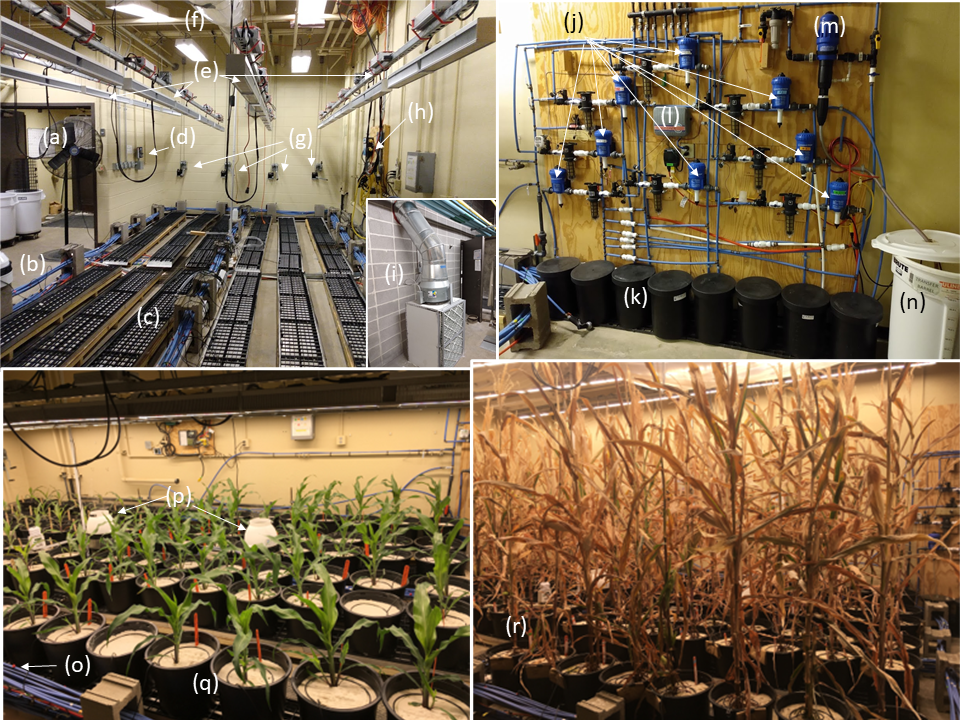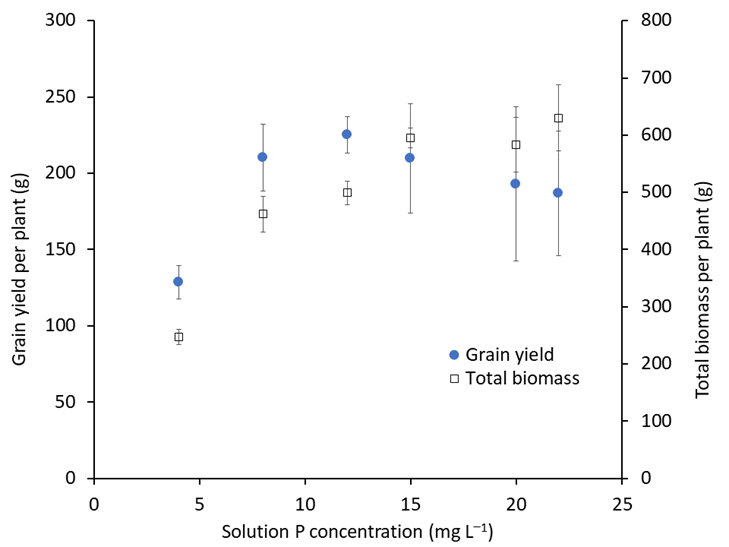By Chad Penn, Soil Scientist at National Soil Erosion Research Laboratory (USDA) and Adjunct Professor at Purdue University

Because of the “sticky” nature of phosphorus (P) to soils and variability between soils in their affinity for P, achieving soil P levels that are “just right” for reaching maximum yield, yet minimum losses to the environment can be tricky. When studying the P needs of plants, one of the most difficult and confounding factors is often the soil itself. For this reason, in our quest for developing a less empirical method of making crop P recommendations, we separated the plant from the soil. This makes it possible to study each individual system in greater detail and with fewer confounding factors before putting them back together again.
This article focuses on the plant alone, avoiding any confounding factors from the soil that supplies P. Specifically, our goal was to answer the question: what is the minimum P uptake by corn for achieving maximum grain yield? To answer the question, we had to develop a technique for growing corn under controlled conditions. Most importantly, it was necessary to be able to precisely control solution P concentrations, which is impossible with soils.
Keep in mind that solution (water) is the medium from which plants take up nutrients; the soil is simply the “warehouse” that supplies the solution. Hydroponics is the traditional tool for controlling the root environment; however, it is not possible to grow realistic corn to maturity in hydroponic systems. Similarly, corn growth in a greenhouse and growth chamber has several disadvantages. For these reasons, we developed a semi-automated technique for growing field-like corn to maturity using a modified hydroponics method. Briefly, the new technique created ideal conditions and successful simulation of light intensity, diurnal fluctuations in temperature and humidity, and changing photoperiod. A soil-like environment was simulated using an inert silica sand that neither adsorbed nor released nutrients, therefore allowing solution nutrient concentrations to be controlled through a drip fertigation system i.e. all applied nutrients are 100% bioavailable. Presentation and validation of this technique are presented in Wiethorn et al. (2021); grain yield, tissue nutrient concentrations, and partitioning were comparable to field-grown corn.
Corn Growth Time Lapse
Here, we present new information on corn P uptake not found in the Wiethorn et al. (2021) publication, the details of which are found in Penn et al. (2022). Measurements of response to six different P concentrations were measured for three different modern corn cultivars. Because there was no interaction between cultivar and response variables, such as grain yield, values were averaged for each P treatment across cultivars and reps. As expected, increased P addition increased grain yield, total biomass, and P uptake. In fact, increased P addition also allowed for greater uptake of most non-P nutrients. However, corn grain yield reached a maximum, and then continued to uptake P (Figure 2a). A “breakpoint” analysis showed that there was indeed a sharp change in grain yield after 584 mg of P uptake per plant. So while the plant continued to uptake more P, there was no benefit to grain yield, which is the “luxury consumption” commonly observed with nitrogen and potassium. Similarly, even though grain yield peaked after 584 mg P uptake, total biomass continued to increase with further P uptake from that point (Figure 2b). Total biomass did reach a plateau, but not until after about 730 mg P uptake, again with the plant taking up additional P without making more biomass. In addition to visual observation, the statistical model suggested that the linear-linear model was a better fit for grain yield, meaning that grain yield significantly decreased with excessive P uptake.

There are several important implications for these results. First, the observation of luxury consumption for P in corn is not well-documented or commonly considered when making P fertility recommendations. Ultimately, this means that over-fertilization of P beyond the point of achieving uptake of more than about 580 mg P per plant is a waste if the goal is to reach maximum grain yield only. However, if the goal is to produce maximum biomass, as is common for silage production, then continued P application to the point of achieving about 730 mg P uptake will indeed produce more biomass, although the same sort of luxury consumption occurs after that point. While it is well known that less P application is required for grain compared to silage production because of greater P removed during silage harvest, it is now apparent that regardless of removal at harvest, less P is needed for reaching maximum grain production due to uptake differences.
Changes in P distribution within the plant highlights P luxury consumption and how increased P addition “builds” a different corn plant. Figure 3 illustrates the percent distribution and mass of P in various plant parts with increased total P uptake. First, increased P uptake generally increases the mass of P in each plant part. However, notice that a greater percentage of P is placed in the stem, cobb, and tassel, while a lower proportion is put into the grain as P uptake increases. Grain P mass (and concentration) continues to increase with further P uptake beyond 580 mg per plant, but grain yield does not increase. The plant is clearly increasing in biomass and building a larger “machine”, but it reaches its genetic potential with regard to grain production; no amount of fertilizer will further increase grain yield under these conditions. From this perspective, increased P fertilization beyond the threshold will promote a higher “quality” grain if quality is defined in this case as being more P-dense, but it will not produce a greater quantity of grain.

Of further interest is the observation that grain yield appeared to actually decrease after the threshold P uptake value of 580 mg per plant was reached (Figure 2). This suggests that increased P uptake posed a negative effect on grain yield. Much has been stated on role of P in Zn, Cu, and Mn uptake, with debate centered around whether or not increased P uptake truly prevents their uptake, and if so, if the mechanism is due to soil chemical reactions or plant physiological processes. In this case, soil was not used so any impact would be due to physiological processes. A future blogpost will explore this scenario and how luxury consumption of P impacts the uptake and partitioning of other nutrients.
In summary, this highly controlled study shed light on corn P needs. It is possible to overfertilize P to the point of luxury consumption in two stages, which may or may not decrease grain yield depending on availability of other nutrients. In the first stage of luxury consumption, corn will continue to uptake P beyond a threshold value of 580 mg per plant, with no benefit in grain yield; any additional P uptake is an economic inefficiency if the goal of the producer is to achieve maximum grain yield only. Additional P fertilization to achieve P uptake from 580 mg to 730 mg per plant will result in further corn biomass production and P-dense grain, but not increase grain yield. In the secondary luxury consumption stage, further uptake beyond 730 mg per plant will not increase corn biomass. While knowledge of these phenomena is helpful, it is currently not known how much P in the soil will result in uptake of 580 or 730 mg per plant. Complicating matters further, Soil P concentrations required to reach such threshold values will vary with soil properties such as pH, mineralogy, and organic matter, as well as management. That will keep me busy for many years.
Citations:
Wiethorn, M., Penn, C., & Camberato, J. (2021). A research method for semi-automated large-scale cultivation of maize to full maturity in an artificial environment. Agronomy, 11(10), 1898.
Penn, C. J., Camberato, J. J., & Wiethorn, M. A. (2022). How much phosphorus uptake is required for achieving maximum maize grain yield? part 1: luxury consumption and implications for yield. Agronomy, 13(1), 95.
Opinions expressed here do not necessarily reflect those of the Sustainable Phosphorus Alliance.